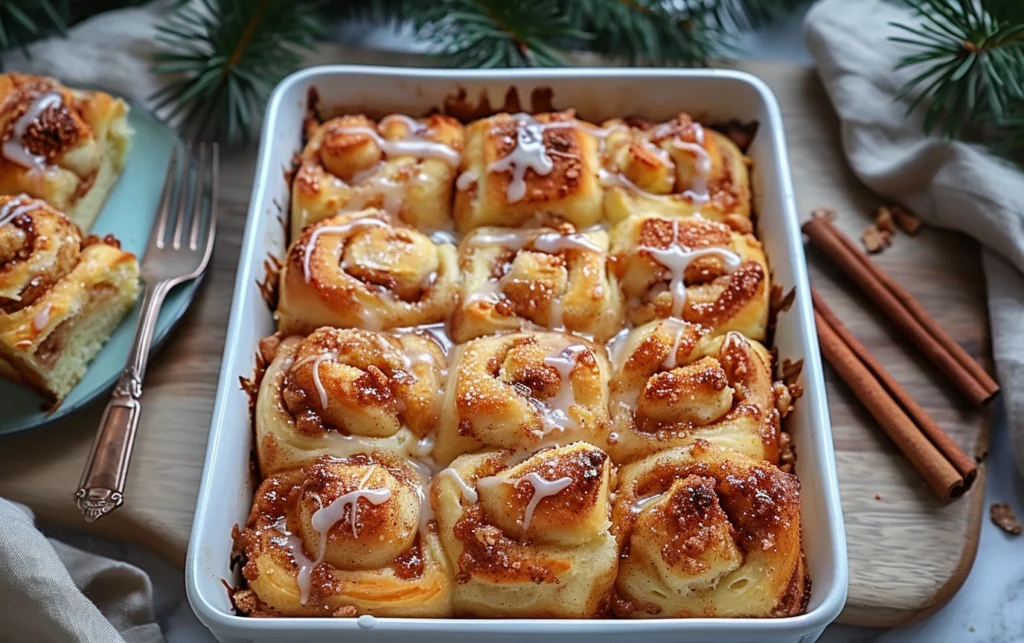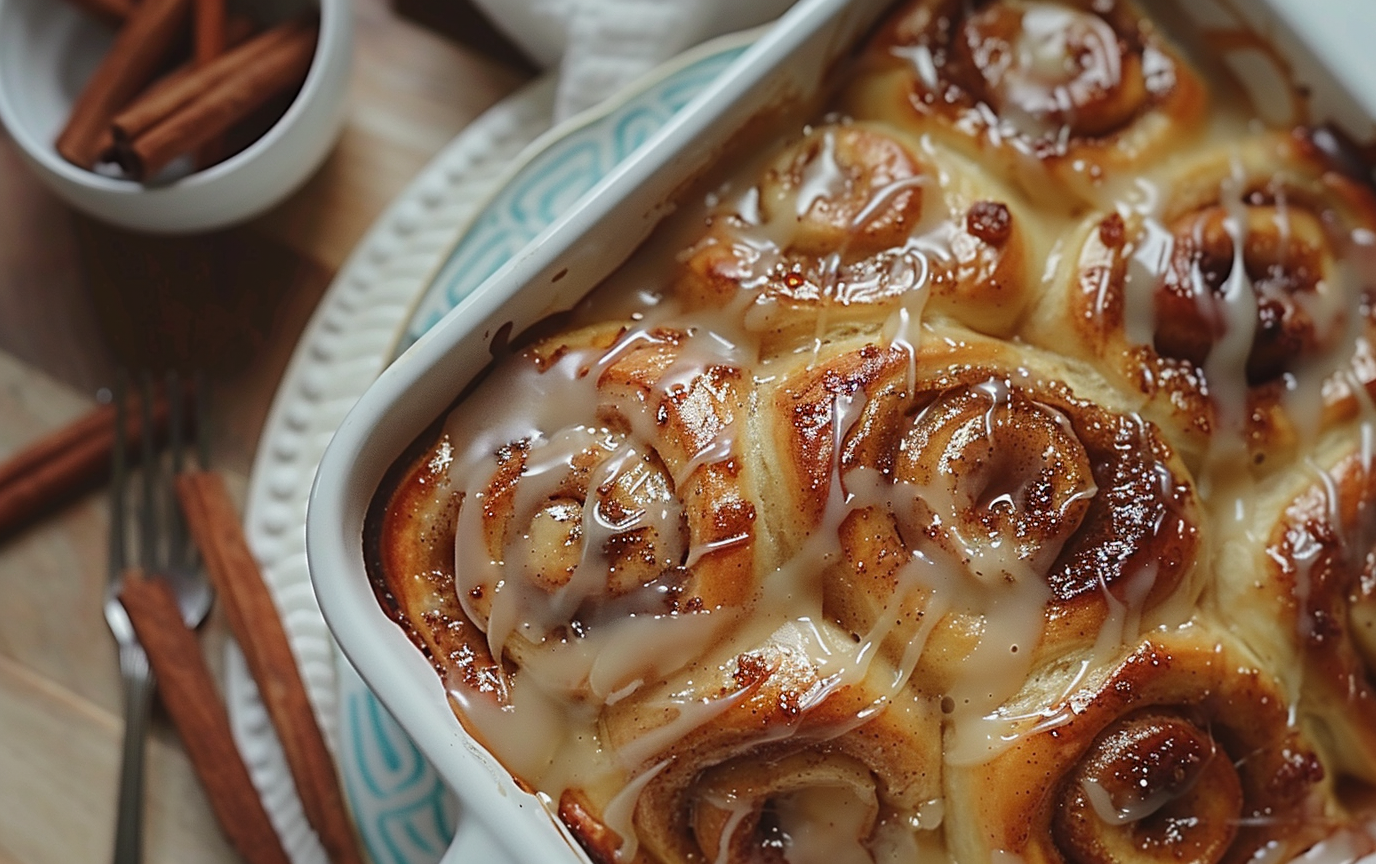Cinnamon Rolls and Cinnabon
When it comes to indulgent pastries, few treats compare to the comforting allure of cinnamon rolls. Yet, if you’ve ever walked past a Cinnabon bakery, you know their signature rolls are in a league of their own. But what is the difference between a cinnamon roll and a Cinnabon? While both share a love for cinnamon and sugar, the differences in ingredients, preparation, and presentation set them apart. This article picks into these nuances, providing clarity for pastry enthusiasts everywhere.
The Ingredients
Understanding the key components is crucial in discerning what is the difference between a cinnamon roll and a Cinnabon.
- Flour: Standard cinnamon rolls often use all-purpose flour, while Cinnabon relies on a proprietary high-gluten flour for that chewy, bakery-quality texture.
- Cinnamon: Most cinnamon rolls use common ground cinnamon. However, Cinnabon’s secret weapon is their exclusive Makara cinnamon, sourced from Indonesia for a more robust flavor.
- Sugar: Both use white granulated sugar, but Cinnabon incorporates brown sugar heavily in its filling, creating a richer caramelized taste.
- Butter: Cinnabon’s emphasis on high-quality butter gives their rolls a richer, creamier finish compared to homemade versions.
These distinctions are part of what creates the deeper, more indulgent experience when biting into a Cinnabon. If you’re looking for ways to increase your own recipes, check out avoiding common sourdough mistakes for tips on perfecting baking techniques.
The Dough
The dough is the foundation of both pastries, yet it plays a pivotal role in what is the difference between a cinnamon roll and a Cinnabon.
- Texture: Homemade cinnamon roll dough is often soft but denser, while Cinnabon’s dough achieves an airy, pillowy consistency due to precise proofing techniques.
- Enrichment: Cinnabon’s dough is enriched with more butter and milk, giving it a moist and tender bite.
- Rising Process: The yeast-based dough of both requires careful proofing, but Cinnabon’s process insures consistent rise, thanks to their tightly controlled environment.
The result? Cinnabon’s rolls have an unmistakable fluffiness that melts in your mouth.
Looking to experiment with creative breakfast ideas? Consider sourdough discard recipes for a fresh take on morning treats.
The Filling Between a Cinnamon Roll and a Cinnabon
A key factor in distinguishing what is the difference between a cinnamon roll and a Cinnabon lies in the filling.
- Layering: Cinnabon applies its filling in thicker, more generous layers, ensuring each bite is packed with flavor.
- Cinnamon Blend: While most cinnamon rolls use a mix of sugar and cinnamon, Cinnabon’s exclusive Makara cinnamon provides a spicier, sweeter kick.
- Butter Incorporation: In Cinnabon rolls, melted butter is layered generously before applying the filling, allowing the sugar to caramelize deeply during baking.
These meticulous details contribute to the trademark gooey center that sets Cinnabon apart.
The Frosting For Cinnamon roll and Cinnabon
Frosting is the crowning glory of both treats, yet it’s another distinguishing feature in what is the difference between a cinnamon roll and a Cinnabon.
- Cream Cheese Frosting: While both use cream cheese frosting, Cinnabon’s recipe is richer, blending more cream cheese and a higher sugar-to-butter ratio.
- Application: Cinnabon’s frosting is applied while the rolls are still warm, allowing it to seep into the crevices for added moisture and flavor.
- Flavor Profile: Homemade cinnamon roll frostings often lean sweeter, but Cinnabon achieves a perfect balance of tanginess and sweetness.
This frosting technique increases the sensory experience of every bite.
If you’ve ever wondered about other unique ingredients, such as whether coconut oil is good for popping popcorn, you’d appreciate how small details can dramatically influence flavor and texture.
Preparation Techniques
Another aspect that highlights what is the difference between a cinnamon roll and a Cinnabon is the preparation technique.
- Consistency: Cinnabon employs precise rolling, layering, and cutting techniques to assure uniformity in size and shape.
- Proofing Conditions: Cinnabon’s proofing process is tightly regulated, creating the optimal environment for yeast activity.
- Baking Time: Their rolls are baked to golden perfection, with slightly crisped edges and a soft, gooey center.
- Homemade Varieties: Homemade cinnamon rolls often have more variation, relying on individual preferences and tools available.
Mastering these techniques is key to replicating bakery-quality results.
Presentation
How these pastries are presented further defines what is the difference between a cinnamon roll and a Cinnabon.

- Cinnabon Presentation:
- Uniform size and spiral consistency.
- Generous application of frosting that drips enticingly down the sides.
- Served warm to emphasize gooey textures.
- Homemade Cinnamon Rolls:
- Greater variation in appearance.
- Frosting application often depends on individual preference, ranging from light drizzles to thick layers.
Cinnabon’s emphasis on visual appeal is one of the reasons they are so iconic.
Flavor Profile
Finally, flavor is the ultimate distinction when exploring what is the difference between a cinnamon roll and a Cinnabon.
- Homemade Cinnamon Rolls:
- Often feature milder cinnamon and sweetness levels.
- The dough’s flavor can vary based on the recipe and ingredients used.
- Frosting provides most of the sweetness.
- Cinnabon Rolls:
- A deeper, more intense cinnamon flavor thanks to Makara cinnamon.
- Caramelized sugar in the filling creates a rich, buttery sweetness.
- Frosting adds tanginess and balance, enhancing the overall flavor harmony.
Cinnabon’s flavor profile is more intense and memorable, which explains its global popularity.
In conclusion, what is the difference between a cinnamon roll and a Cinnabon? While both share similar roots, the differences lie in their ingredients, preparation, and presentation. Cinnabon’s meticulous attention to detail insures a consistently indulgent experience, making it the gold standard for cinnamon rolls. Whether you prefer the simplicity of homemade rolls or the iconic decadence of Cinnabon, both have a special place in the world of baked goods.
Nutritional Information
When comparing cinnamon rolls and Cinnabon treats, their nutritional content stands out as a critical difference. Both are indulgent treats, but their caloric and nutrient profiles vary significantly.
- Cinnamon Rolls:
- Typically range between 300-500 calories depending on size and recipe.
- Contain about 10-20g of fat, often influenced by the use of butter and icing.
- Offer 40-70g of carbohydrates, mainly from flour and sugar.
- Protein content is moderate at 5-8g.
- Cinnabon Rolls:
- Known for being calorie-dense, with their classic roll reaching 800-900 calories.
- Contain higher fat levels at 30-40g, emphasizing their rich, buttery flavor.
- Feature 100-120g of carbohydrates, with added sugars contributing significantly.
- Protein levels are slightly higher, averaging 10-12g.
What is the difference between a cinnamon roll and a Cinnabon? The answer lies in their preparation. Cinnabon prioritizes indulgence, using a proprietary blend of Makara cinnamon and an icing formula that amplifies sweetness and fat content.
Popularity and Availability
What is the difference between a cinnamon roll and a Cinnabon in terms of popularity? Cinnabon dominates globally, while traditional cinnamon rolls are regionally cherished.
- Cinnamon Rolls:
- Found in bakeries, cafes, and homemade recipes worldwide.
- Their availability depends on local traditions, with variations in Scandinavia, Germany, and North America.
- Cinnabon:
- A globally recognized franchise with over 1,200 locations.
- Marketed as a luxury treat, making them a go-to choice in malls, airports, and high-traffic areas.
- Relies on a standardized recipe, ensuring consistent flavor.
Transitioning from homemade cinnamon rolls to a Cinnabon experience reveals how global branding and recipe exclusivity shape customer preferences.
Cost Comparison between Cinnamon Roll and Cinnabon
The cost factor is another distinction when asking, What is the difference between a cinnamon roll and a Cinnabon? Pricing can influence your choice based on indulgence versus affordability.
- Cinnamon Rolls:
- Homemade cinnamon rolls cost less, with basic ingredients totaling around $5-$10 for a dozen.
- Bakery cinnamon rolls range between $2-$4 each, depending on size and location.
- Cinnabon:
- Positioned as a premium product, costing $4-$6 per roll.
- Packs of six or more may reduce per-unit cost but remain higher than alternatives.
Key takeaway: The cost reflects the premium branding and proprietary ingredients used in Cinnabon products, while traditional cinnamon rolls emphasize versatility and affordability.
Cultural Impact for Cinnamon Roll and Cinnabon
The cultural impact is profound, especially when considering What is the difference between a cinnamon roll and a Cinnabon? Both have shaped food culture uniquely.
- Cinnamon Rolls:
- Steeped in tradition, with roots in Scandinavian “kanelbulle” and German “zimtschnecken.”
- Commonly served during holidays or at family gatherings.
- Symbolize homemade warmth and hospitality.
- Cinnabon:
- Represents modern indulgence and marketing mastery.
- Iconic for creating sensory-driven environments in shopping malls.
- Plays a role in pop culture, appearing in movies and TV shows.
Transition words such as “however” and “meanwhile” underscore how Cinnabon has commercialized the cinnamon roll experience, contrasting with its traditional heritage.
DIY vs Store-Bought
The debate between DIY and store-bought options reveals another dimension of What is the difference between a cinnamon roll and a Cinnabon?
- DIY Cinnamon Rolls:
- Allow control over ingredients, making it easier to customize for dietary preferences.
- Offer a hands-on experience, adding a personal touch to the final product.
- Cost-effective and healthier, with fewer preservatives and less sugar.
- Store-Bought Cinnabon:
- Insures consistency and flavor without the effort of preparation.
- Convenient for on-the-go indulgence or gifting.
- Delivers a rich, signature taste that DIY attempts often can’t replicate.
Transitioning from DIY to store-bought often boils down to balancing convenience with personalization.
FAQ
What is the difference between a cinnamon roll and a Cinnabon?
Cinnabon focuses on a decadent experience using proprietary ingredients, while cinnamon rolls are versatile and vary by region and recipe.
Are cinnamon rolls healthier than Cinnabon?
Yes, traditional cinnamon rolls, especially homemade ones, tend to have fewer calories, fat, and sugar than a classic Cinnabon roll.
Can I replicate Cinnabon at home?
You can attempt to mimic Cinnabon by using high-quality cinnamon, plenty of butter, and cream cheese icing, but the proprietary Makara cinnamon and dough recipe remain exclusive.
Why does Cinnabon smell so good?
Cinnabon strategically uses warm ovens and fans to disperse the scent of freshly baked rolls, enhancing its appeal.
Understanding What is the difference between a cinnamon roll and a Cinnabon? involves exploring their nutritional, cultural, and experiential differences. While cinnamon rolls emphasize tradition, affordability, and flexibility, Cinnabon offers a premium, indulgent treat with global recognition. Whether you opt for a DIY approach or a store-bought indulgence, both satisfy the universal love for cinnamon and sweetness. Choose based on your preference for tradition, cost, or luxury.

